Manage Knowledge and Information Short Answer
VerifiedAdded on 2023/06/18
|10
|2506
|348
AI Summary
This article provides short answer questions and answers related to managing knowledge and information. It covers topics such as reviewing feedback and performance data, disseminating information, analyzing information and knowledge, making decisions on identified business issues, and more. The article also includes a checklist for students to ensure they have covered all the questions.
Contribute Materials
Your contribution can guide someone’s learning journey. Share your
documents today.
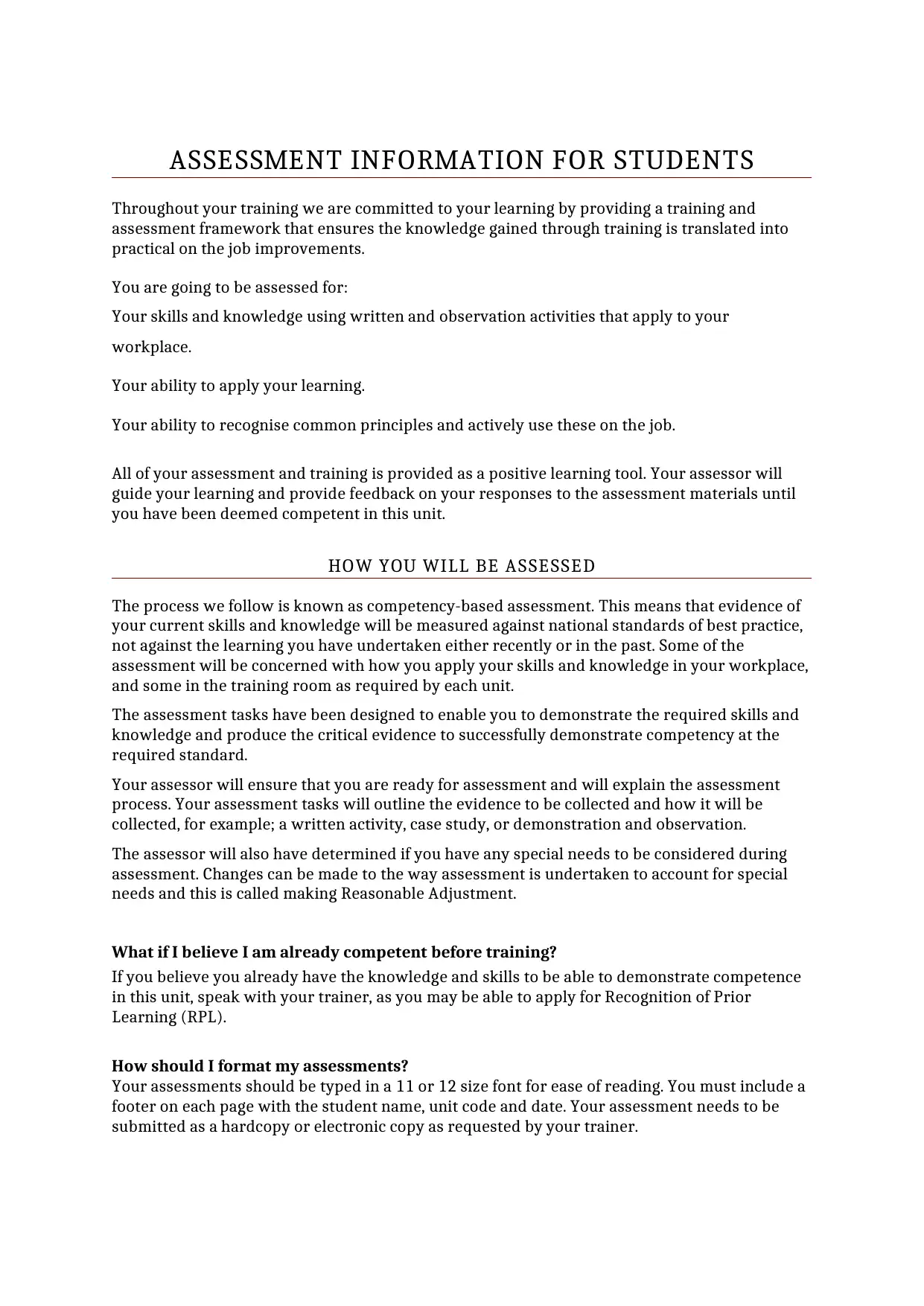
ASSESSMENT INFORMATION FOR STUDENTS
Throughout your training we are committed to your learning by providing a training and
assessment framework that ensures the knowledge gained through training is translated into
practical on the job improvements.
You are going to be assessed for:
Your skills and knowledge using written and observation activities that apply to your
workplace.
Your ability to apply your learning.
Your ability to recognise common principles and actively use these on the job.
All of your assessment and training is provided as a positive learning tool. Your assessor will
guide your learning and provide feedback on your responses to the assessment materials until
you have been deemed competent in this unit.
HOW YOU WILL BE ASSESSED
The process we follow is known as competency-based assessment. This means that evidence of
your current skills and knowledge will be measured against national standards of best practice,
not against the learning you have undertaken either recently or in the past. Some of the
assessment will be concerned with how you apply your skills and knowledge in your workplace,
and some in the training room as required by each unit.
The assessment tasks have been designed to enable you to demonstrate the required skills and
knowledge and produce the critical evidence to successfully demonstrate competency at the
required standard.
Your assessor will ensure that you are ready for assessment and will explain the assessment
process. Your assessment tasks will outline the evidence to be collected and how it will be
collected, for example; a written activity, case study, or demonstration and observation.
The assessor will also have determined if you have any special needs to be considered during
assessment. Changes can be made to the way assessment is undertaken to account for special
needs and this is called making Reasonable Adjustment.
What if I believe I am already competent before training?
If you believe you already have the knowledge and skills to be able to demonstrate competence
in this unit, speak with your trainer, as you may be able to apply for Recognition of Prior
Learning (RPL).
How should I format my assessments?
Your assessments should be typed in a 11 or 12 size font for ease of reading. You must include a
footer on each page with the student name, unit code and date. Your assessment needs to be
submitted as a hardcopy or electronic copy as requested by your trainer.
Throughout your training we are committed to your learning by providing a training and
assessment framework that ensures the knowledge gained through training is translated into
practical on the job improvements.
You are going to be assessed for:
Your skills and knowledge using written and observation activities that apply to your
workplace.
Your ability to apply your learning.
Your ability to recognise common principles and actively use these on the job.
All of your assessment and training is provided as a positive learning tool. Your assessor will
guide your learning and provide feedback on your responses to the assessment materials until
you have been deemed competent in this unit.
HOW YOU WILL BE ASSESSED
The process we follow is known as competency-based assessment. This means that evidence of
your current skills and knowledge will be measured against national standards of best practice,
not against the learning you have undertaken either recently or in the past. Some of the
assessment will be concerned with how you apply your skills and knowledge in your workplace,
and some in the training room as required by each unit.
The assessment tasks have been designed to enable you to demonstrate the required skills and
knowledge and produce the critical evidence to successfully demonstrate competency at the
required standard.
Your assessor will ensure that you are ready for assessment and will explain the assessment
process. Your assessment tasks will outline the evidence to be collected and how it will be
collected, for example; a written activity, case study, or demonstration and observation.
The assessor will also have determined if you have any special needs to be considered during
assessment. Changes can be made to the way assessment is undertaken to account for special
needs and this is called making Reasonable Adjustment.
What if I believe I am already competent before training?
If you believe you already have the knowledge and skills to be able to demonstrate competence
in this unit, speak with your trainer, as you may be able to apply for Recognition of Prior
Learning (RPL).
How should I format my assessments?
Your assessments should be typed in a 11 or 12 size font for ease of reading. You must include a
footer on each page with the student name, unit code and date. Your assessment needs to be
submitted as a hardcopy or electronic copy as requested by your trainer.
Secure Best Marks with AI Grader
Need help grading? Try our AI Grader for instant feedback on your assignments.
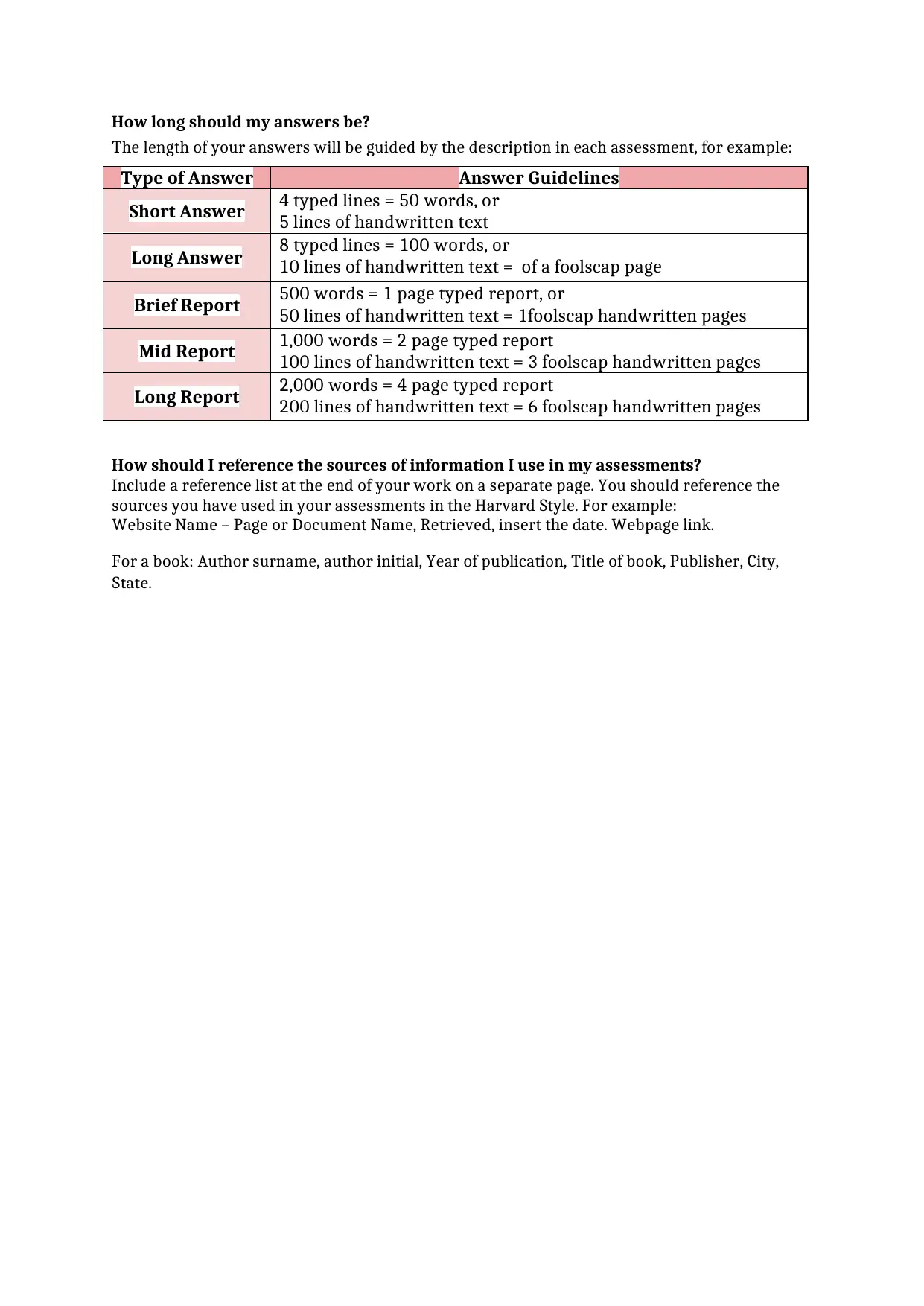
How long should my answers be?
The length of your answers will be guided by the description in each assessment, for example:
Type of Answer Answer Guidelines
Short Answer 4 typed lines = 50 words, or
5 lines of handwritten text
Long Answer 8 typed lines = 100 words, or
10 lines of handwritten text = of a foolscap page
Brief Report 500 words = 1 page typed report, or
50 lines of handwritten text = 1foolscap handwritten pages
Mid Report 1,000 words = 2 page typed report
100 lines of handwritten text = 3 foolscap handwritten pages
Long Report 2,000 words = 4 page typed report
200 lines of handwritten text = 6 foolscap handwritten pages
How should I reference the sources of information I use in my assessments?
Include a reference list at the end of your work on a separate page. You should reference the
sources you have used in your assessments in the Harvard Style. For example:
Website Name – Page or Document Name, Retrieved, insert the date. Webpage link.
For a book: Author surname, author initial, Year of publication, Title of book, Publisher, City,
State.
The length of your answers will be guided by the description in each assessment, for example:
Type of Answer Answer Guidelines
Short Answer 4 typed lines = 50 words, or
5 lines of handwritten text
Long Answer 8 typed lines = 100 words, or
10 lines of handwritten text = of a foolscap page
Brief Report 500 words = 1 page typed report, or
50 lines of handwritten text = 1foolscap handwritten pages
Mid Report 1,000 words = 2 page typed report
100 lines of handwritten text = 3 foolscap handwritten pages
Long Report 2,000 words = 4 page typed report
200 lines of handwritten text = 6 foolscap handwritten pages
How should I reference the sources of information I use in my assessments?
Include a reference list at the end of your work on a separate page. You should reference the
sources you have used in your assessments in the Harvard Style. For example:
Website Name – Page or Document Name, Retrieved, insert the date. Webpage link.
For a book: Author surname, author initial, Year of publication, Title of book, Publisher, City,
State.
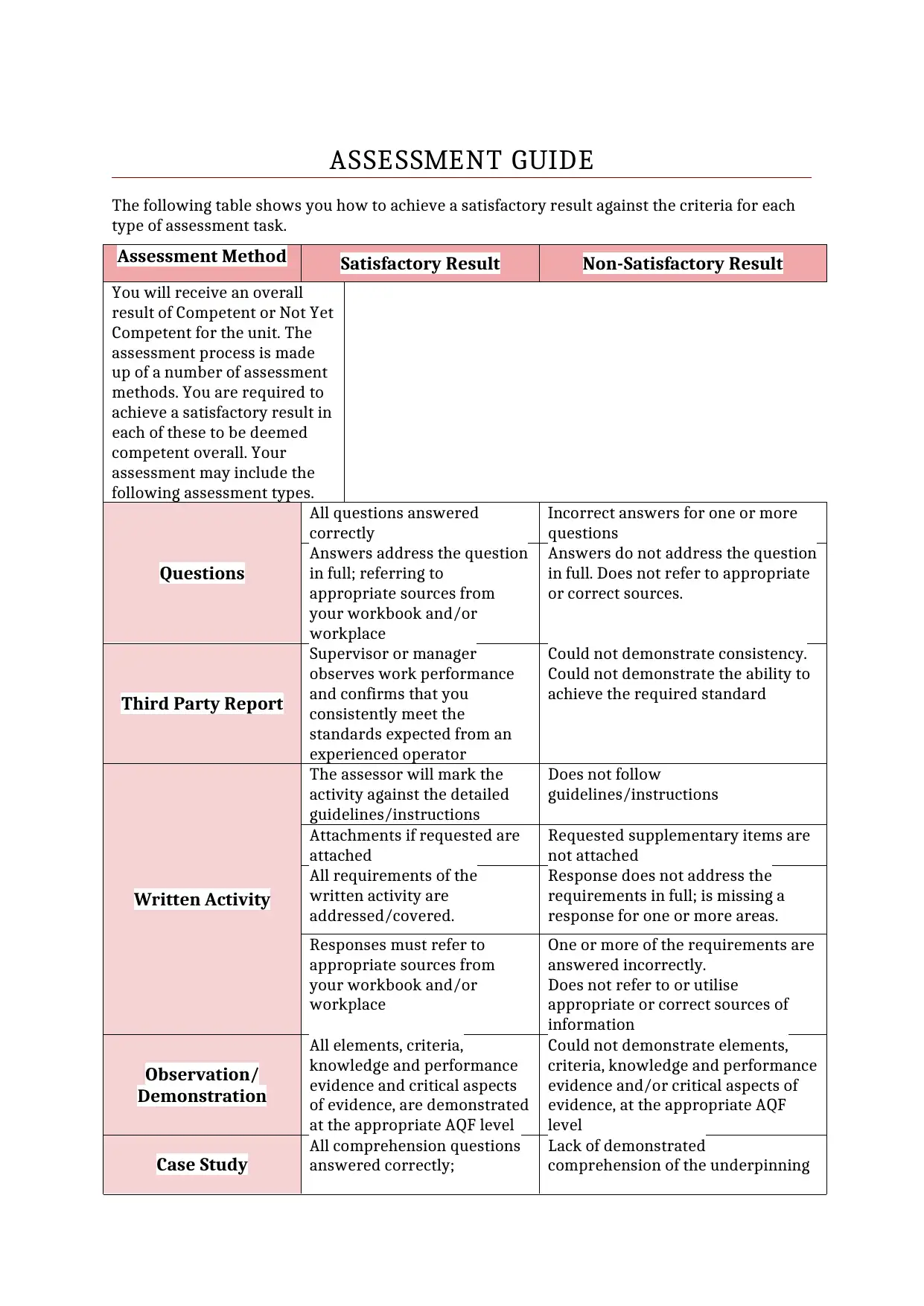
ASSESSMENT GUIDE
The following table shows you how to achieve a satisfactory result against the criteria for each
type of assessment task.
Assessment Method Satisfactory Result Non-Satisfactory Result
You will receive an overall
result of Competent or Not Yet
Competent for the unit. The
assessment process is made
up of a number of assessment
methods. You are required to
achieve a satisfactory result in
each of these to be deemed
competent overall. Your
assessment may include the
following assessment types.
Questions
All questions answered
correctly
Incorrect answers for one or more
questions
Answers address the question
in full; referring to
appropriate sources from
your workbook and/or
workplace
Answers do not address the question
in full. Does not refer to appropriate
or correct sources.
Third Party Report
Supervisor or manager
observes work performance
and confirms that you
consistently meet the
standards expected from an
experienced operator
Could not demonstrate consistency.
Could not demonstrate the ability to
achieve the required standard
Written Activity
The assessor will mark the
activity against the detailed
guidelines/instructions
Does not follow
guidelines/instructions
Attachments if requested are
attached
Requested supplementary items are
not attached
All requirements of the
written activity are
addressed/covered.
Response does not address the
requirements in full; is missing a
response for one or more areas.
Responses must refer to
appropriate sources from
your workbook and/or
workplace
One or more of the requirements are
answered incorrectly.
Does not refer to or utilise
appropriate or correct sources of
information
Observation/
Demonstration
All elements, criteria,
knowledge and performance
evidence and critical aspects
of evidence, are demonstrated
at the appropriate AQF level
Could not demonstrate elements,
criteria, knowledge and performance
evidence and/or critical aspects of
evidence, at the appropriate AQF
level
Case Study
All comprehension questions
answered correctly;
Lack of demonstrated
comprehension of the underpinning
The following table shows you how to achieve a satisfactory result against the criteria for each
type of assessment task.
Assessment Method Satisfactory Result Non-Satisfactory Result
You will receive an overall
result of Competent or Not Yet
Competent for the unit. The
assessment process is made
up of a number of assessment
methods. You are required to
achieve a satisfactory result in
each of these to be deemed
competent overall. Your
assessment may include the
following assessment types.
Questions
All questions answered
correctly
Incorrect answers for one or more
questions
Answers address the question
in full; referring to
appropriate sources from
your workbook and/or
workplace
Answers do not address the question
in full. Does not refer to appropriate
or correct sources.
Third Party Report
Supervisor or manager
observes work performance
and confirms that you
consistently meet the
standards expected from an
experienced operator
Could not demonstrate consistency.
Could not demonstrate the ability to
achieve the required standard
Written Activity
The assessor will mark the
activity against the detailed
guidelines/instructions
Does not follow
guidelines/instructions
Attachments if requested are
attached
Requested supplementary items are
not attached
All requirements of the
written activity are
addressed/covered.
Response does not address the
requirements in full; is missing a
response for one or more areas.
Responses must refer to
appropriate sources from
your workbook and/or
workplace
One or more of the requirements are
answered incorrectly.
Does not refer to or utilise
appropriate or correct sources of
information
Observation/
Demonstration
All elements, criteria,
knowledge and performance
evidence and critical aspects
of evidence, are demonstrated
at the appropriate AQF level
Could not demonstrate elements,
criteria, knowledge and performance
evidence and/or critical aspects of
evidence, at the appropriate AQF
level
Case Study
All comprehension questions
answered correctly;
Lack of demonstrated
comprehension of the underpinning
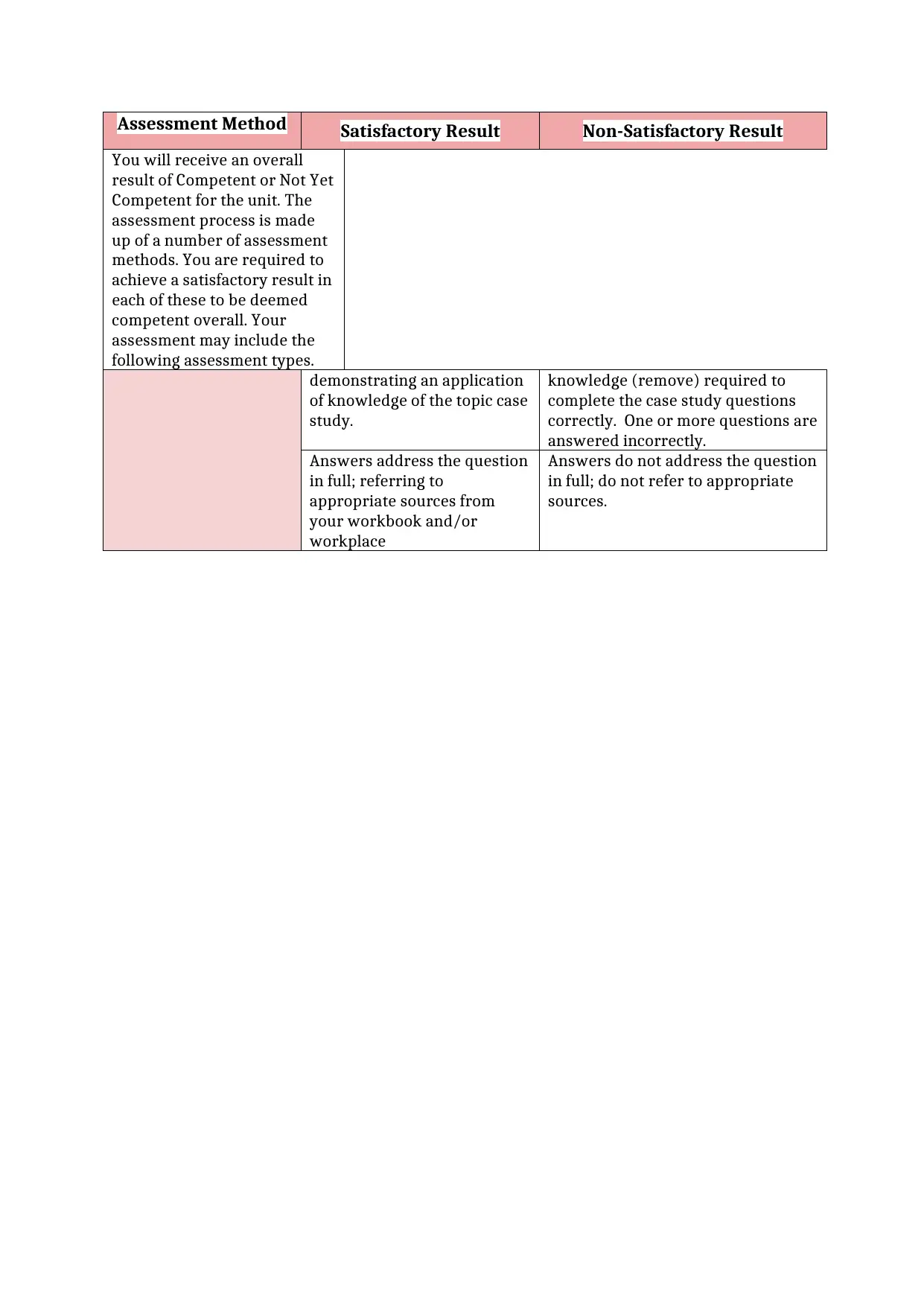
Assessment Method Satisfactory Result Non-Satisfactory Result
You will receive an overall
result of Competent or Not Yet
Competent for the unit. The
assessment process is made
up of a number of assessment
methods. You are required to
achieve a satisfactory result in
each of these to be deemed
competent overall. Your
assessment may include the
following assessment types.
demonstrating an application
of knowledge of the topic case
study.
knowledge (remove) required to
complete the case study questions
correctly. One or more questions are
answered incorrectly.
Answers address the question
in full; referring to
appropriate sources from
your workbook and/or
workplace
Answers do not address the question
in full; do not refer to appropriate
sources.
You will receive an overall
result of Competent or Not Yet
Competent for the unit. The
assessment process is made
up of a number of assessment
methods. You are required to
achieve a satisfactory result in
each of these to be deemed
competent overall. Your
assessment may include the
following assessment types.
demonstrating an application
of knowledge of the topic case
study.
knowledge (remove) required to
complete the case study questions
correctly. One or more questions are
answered incorrectly.
Answers address the question
in full; referring to
appropriate sources from
your workbook and/or
workplace
Answers do not address the question
in full; do not refer to appropriate
sources.
Secure Best Marks with AI Grader
Need help grading? Try our AI Grader for instant feedback on your assignments.
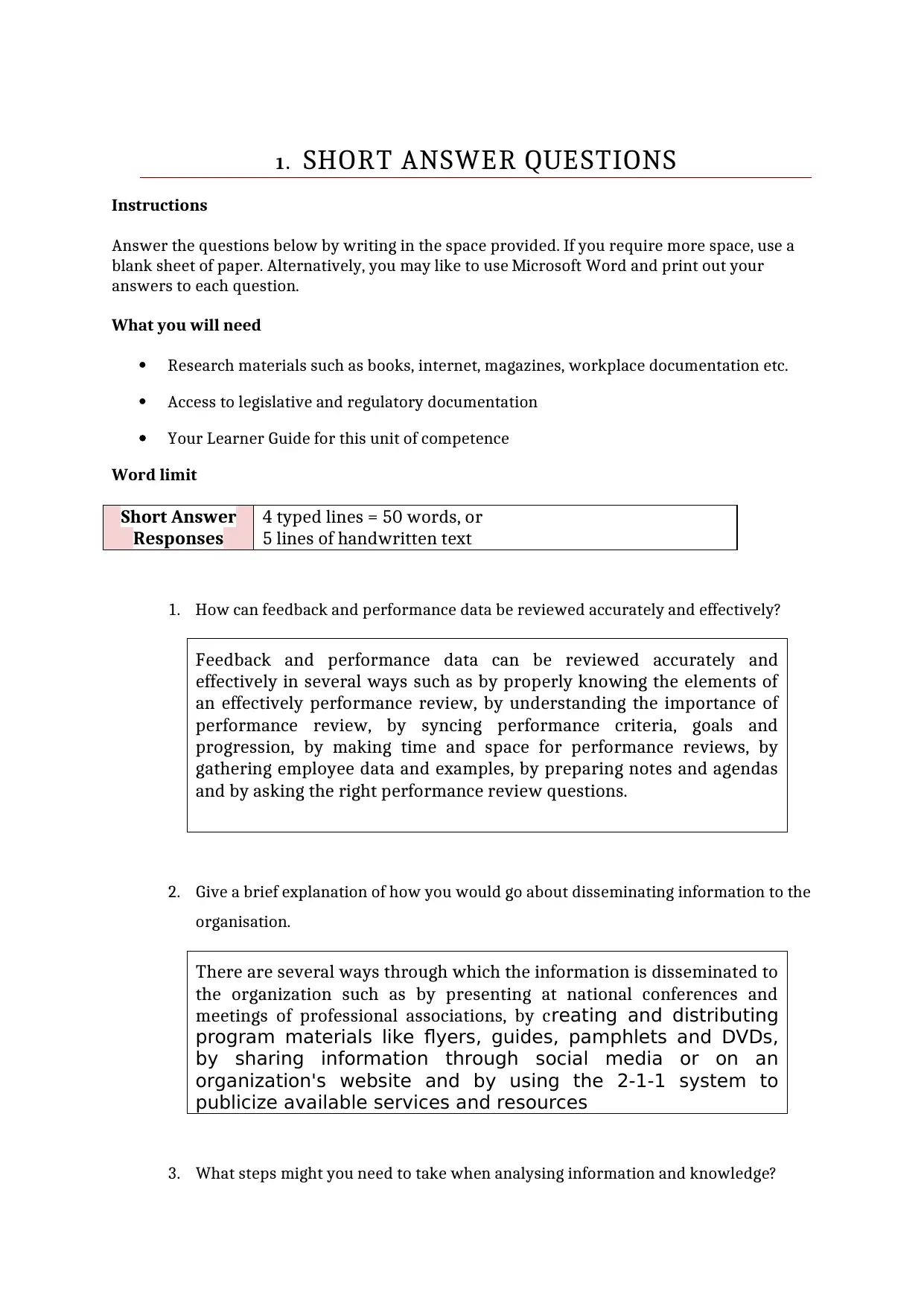
1. SHORT ANSWER QUESTIONS
Instructions
Answer the questions below by writing in the space provided. If you require more space, use a
blank sheet of paper. Alternatively, you may like to use Microsoft Word and print out your
answers to each question.
What you will need
Research materials such as books, internet, magazines, workplace documentation etc.
Access to legislative and regulatory documentation
Your Learner Guide for this unit of competence
Word limit
Short Answer
Responses
4 typed lines = 50 words, or
5 lines of handwritten text
1. How can feedback and performance data be reviewed accurately and effectively?
Feedback and performance data can be reviewed accurately and
effectively in several ways such as by properly knowing the elements of
an effectively performance review, by understanding the importance of
performance review, by syncing performance criteria, goals and
progression, by making time and space for performance reviews, by
gathering employee data and examples, by preparing notes and agendas
and by asking the right performance review questions.
2. Give a brief explanation of how you would go about disseminating information to the
organisation.
There are several ways through which the information is disseminated to
the organization such as by presenting at national conferences and
meetings of professional associations, by creating and distributing
program materials like flyers, guides, pamphlets and DVDs,
by sharing information through social media or on an
organization's website and by using the 2-1-1 system to
publicize available services and resources
3. What steps might you need to take when analysing information and knowledge?
Instructions
Answer the questions below by writing in the space provided. If you require more space, use a
blank sheet of paper. Alternatively, you may like to use Microsoft Word and print out your
answers to each question.
What you will need
Research materials such as books, internet, magazines, workplace documentation etc.
Access to legislative and regulatory documentation
Your Learner Guide for this unit of competence
Word limit
Short Answer
Responses
4 typed lines = 50 words, or
5 lines of handwritten text
1. How can feedback and performance data be reviewed accurately and effectively?
Feedback and performance data can be reviewed accurately and
effectively in several ways such as by properly knowing the elements of
an effectively performance review, by understanding the importance of
performance review, by syncing performance criteria, goals and
progression, by making time and space for performance reviews, by
gathering employee data and examples, by preparing notes and agendas
and by asking the right performance review questions.
2. Give a brief explanation of how you would go about disseminating information to the
organisation.
There are several ways through which the information is disseminated to
the organization such as by presenting at national conferences and
meetings of professional associations, by creating and distributing
program materials like flyers, guides, pamphlets and DVDs,
by sharing information through social media or on an
organization's website and by using the 2-1-1 system to
publicize available services and resources
3. What steps might you need to take when analysing information and knowledge?
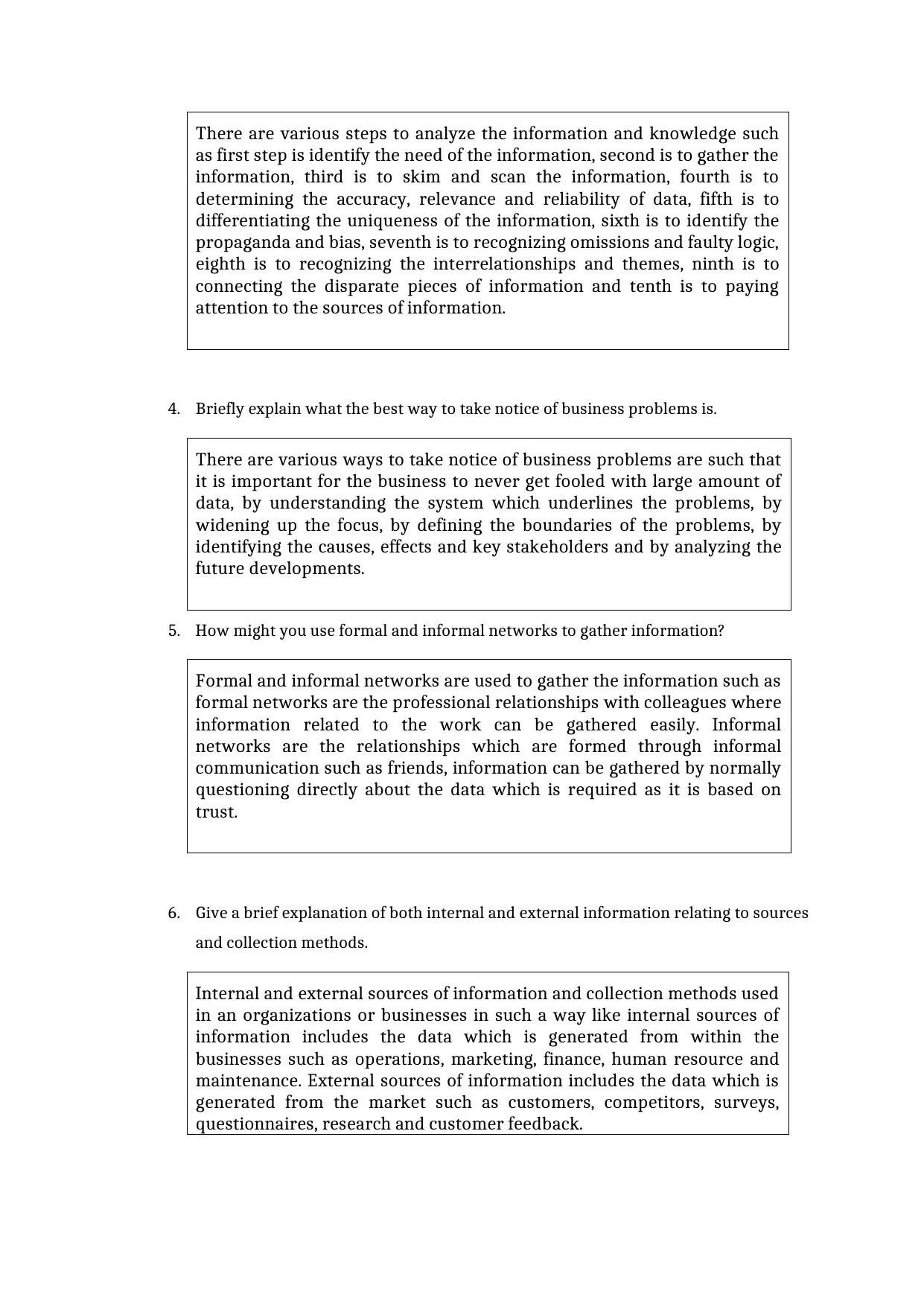
There are various steps to analyze the information and knowledge such
as first step is identify the need of the information, second is to gather the
information, third is to skim and scan the information, fourth is to
determining the accuracy, relevance and reliability of data, fifth is to
differentiating the uniqueness of the information, sixth is to identify the
propaganda and bias, seventh is to recognizing omissions and faulty logic,
eighth is to recognizing the interrelationships and themes, ninth is to
connecting the disparate pieces of information and tenth is to paying
attention to the sources of information.
4. Briefly explain what the best way to take notice of business problems is.
There are various ways to take notice of business problems are such that
it is important for the business to never get fooled with large amount of
data, by understanding the system which underlines the problems, by
widening up the focus, by defining the boundaries of the problems, by
identifying the causes, effects and key stakeholders and by analyzing the
future developments.
5. How might you use formal and informal networks to gather information?
Formal and informal networks are used to gather the information such as
formal networks are the professional relationships with colleagues where
information related to the work can be gathered easily. Informal
networks are the relationships which are formed through informal
communication such as friends, information can be gathered by normally
questioning directly about the data which is required as it is based on
trust.
6. Give a brief explanation of both internal and external information relating to sources
and collection methods.
Internal and external sources of information and collection methods used
in an organizations or businesses in such a way like internal sources of
information includes the data which is generated from within the
businesses such as operations, marketing, finance, human resource and
maintenance. External sources of information includes the data which is
generated from the market such as customers, competitors, surveys,
questionnaires, research and customer feedback.
as first step is identify the need of the information, second is to gather the
information, third is to skim and scan the information, fourth is to
determining the accuracy, relevance and reliability of data, fifth is to
differentiating the uniqueness of the information, sixth is to identify the
propaganda and bias, seventh is to recognizing omissions and faulty logic,
eighth is to recognizing the interrelationships and themes, ninth is to
connecting the disparate pieces of information and tenth is to paying
attention to the sources of information.
4. Briefly explain what the best way to take notice of business problems is.
There are various ways to take notice of business problems are such that
it is important for the business to never get fooled with large amount of
data, by understanding the system which underlines the problems, by
widening up the focus, by defining the boundaries of the problems, by
identifying the causes, effects and key stakeholders and by analyzing the
future developments.
5. How might you use formal and informal networks to gather information?
Formal and informal networks are used to gather the information such as
formal networks are the professional relationships with colleagues where
information related to the work can be gathered easily. Informal
networks are the relationships which are formed through informal
communication such as friends, information can be gathered by normally
questioning directly about the data which is required as it is based on
trust.
6. Give a brief explanation of both internal and external information relating to sources
and collection methods.
Internal and external sources of information and collection methods used
in an organizations or businesses in such a way like internal sources of
information includes the data which is generated from within the
businesses such as operations, marketing, finance, human resource and
maintenance. External sources of information includes the data which is
generated from the market such as customers, competitors, surveys,
questionnaires, research and customer feedback.
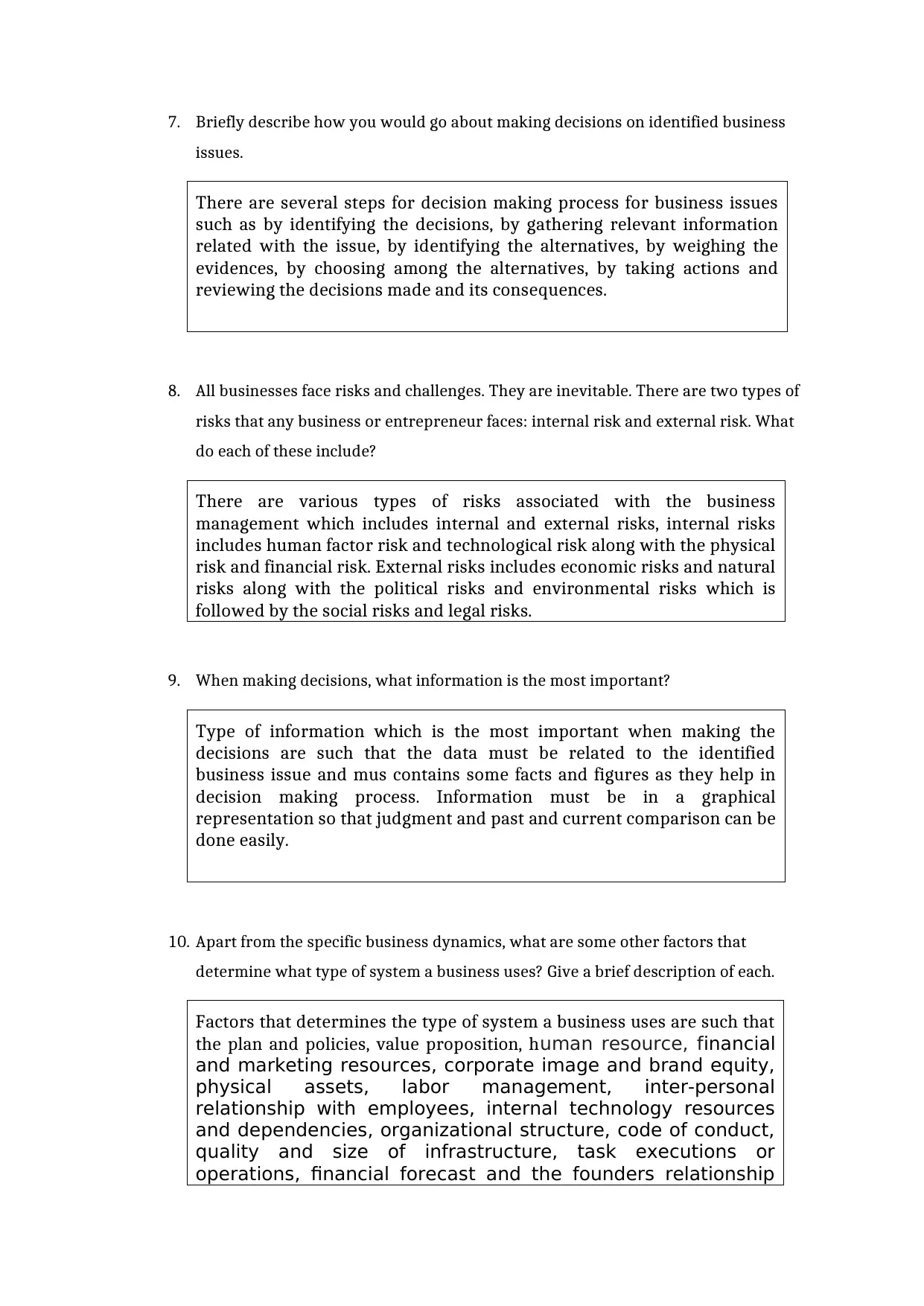
7. Briefly describe how you would go about making decisions on identified business
issues.
There are several steps for decision making process for business issues
such as by identifying the decisions, by gathering relevant information
related with the issue, by identifying the alternatives, by weighing the
evidences, by choosing among the alternatives, by taking actions and
reviewing the decisions made and its consequences.
8. All businesses face risks and challenges. They are inevitable. There are two types of
risks that any business or entrepreneur faces: internal risk and external risk. What
do each of these include?
There are various types of risks associated with the business
management which includes internal and external risks, internal risks
includes human factor risk and technological risk along with the physical
risk and financial risk. External risks includes economic risks and natural
risks along with the political risks and environmental risks which is
followed by the social risks and legal risks.
9. When making decisions, what information is the most important?
Type of information which is the most important when making the
decisions are such that the data must be related to the identified
business issue and mus contains some facts and figures as they help in
decision making process. Information must be in a graphical
representation so that judgment and past and current comparison can be
done easily.
10. Apart from the specific business dynamics, what are some other factors that
determine what type of system a business uses? Give a brief description of each.
Factors that determines the type of system a business uses are such that
the plan and policies, value proposition, human resource, financial
and marketing resources, corporate image and brand equity,
physical assets, labor management, inter-personal
relationship with employees, internal technology resources
and dependencies, organizational structure, code of conduct,
quality and size of infrastructure, task executions or
operations, financial forecast and the founders relationship
issues.
There are several steps for decision making process for business issues
such as by identifying the decisions, by gathering relevant information
related with the issue, by identifying the alternatives, by weighing the
evidences, by choosing among the alternatives, by taking actions and
reviewing the decisions made and its consequences.
8. All businesses face risks and challenges. They are inevitable. There are two types of
risks that any business or entrepreneur faces: internal risk and external risk. What
do each of these include?
There are various types of risks associated with the business
management which includes internal and external risks, internal risks
includes human factor risk and technological risk along with the physical
risk and financial risk. External risks includes economic risks and natural
risks along with the political risks and environmental risks which is
followed by the social risks and legal risks.
9. When making decisions, what information is the most important?
Type of information which is the most important when making the
decisions are such that the data must be related to the identified
business issue and mus contains some facts and figures as they help in
decision making process. Information must be in a graphical
representation so that judgment and past and current comparison can be
done easily.
10. Apart from the specific business dynamics, what are some other factors that
determine what type of system a business uses? Give a brief description of each.
Factors that determines the type of system a business uses are such that
the plan and policies, value proposition, human resource, financial
and marketing resources, corporate image and brand equity,
physical assets, labor management, inter-personal
relationship with employees, internal technology resources
and dependencies, organizational structure, code of conduct,
quality and size of infrastructure, task executions or
operations, financial forecast and the founders relationship
Paraphrase This Document
Need a fresh take? Get an instant paraphrase of this document with our AI Paraphraser
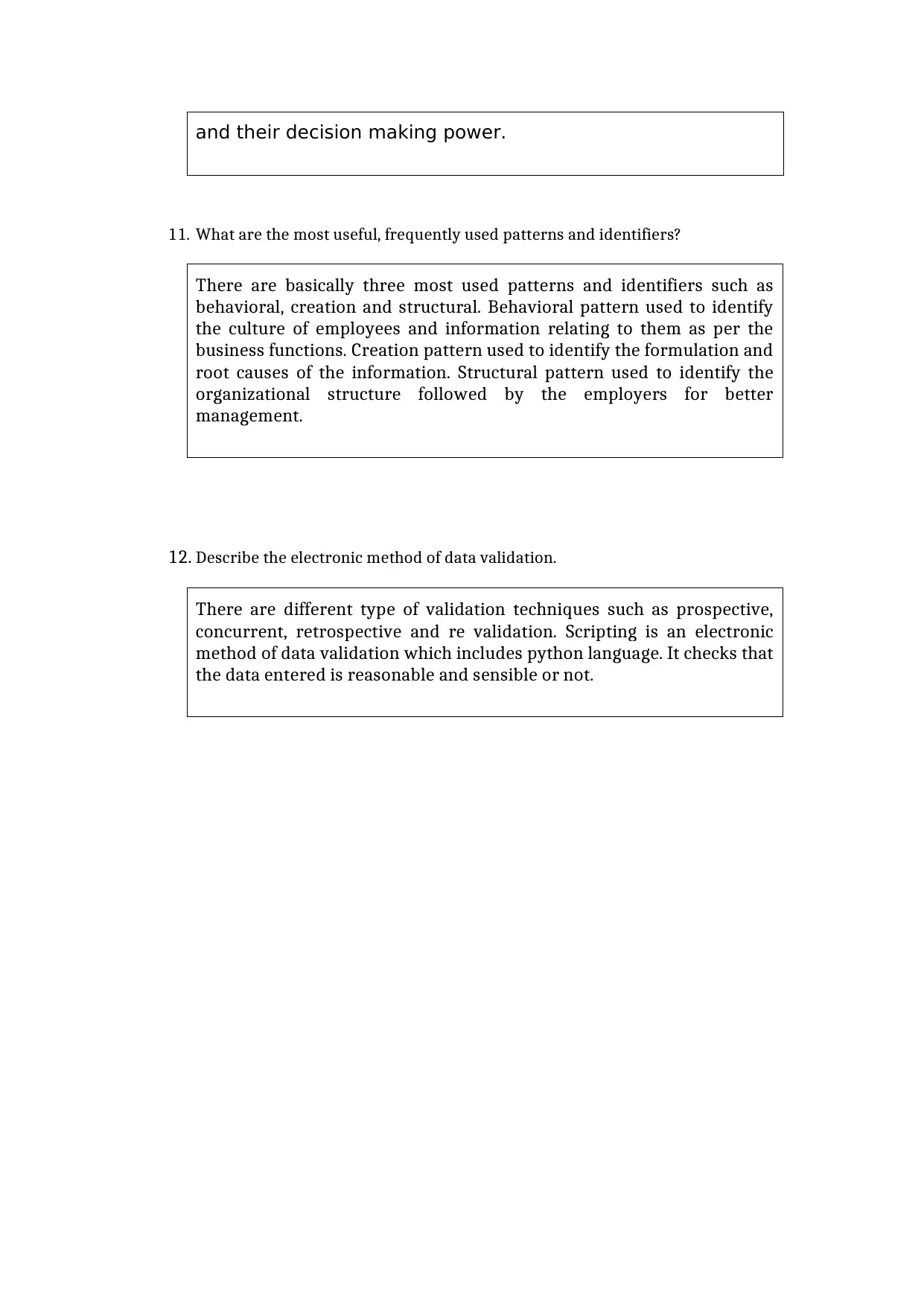
and their decision making power.
11. What are the most useful, frequently used patterns and identifiers?
There are basically three most used patterns and identifiers such as
behavioral, creation and structural. Behavioral pattern used to identify
the culture of employees and information relating to them as per the
business functions. Creation pattern used to identify the formulation and
root causes of the information. Structural pattern used to identify the
organizational structure followed by the employers for better
management.
12. Describe the electronic method of data validation.
There are different type of validation techniques such as prospective,
concurrent, retrospective and re validation. Scripting is an electronic
method of data validation which includes python language. It checks that
the data entered is reasonable and sensible or not.
11. What are the most useful, frequently used patterns and identifiers?
There are basically three most used patterns and identifiers such as
behavioral, creation and structural. Behavioral pattern used to identify
the culture of employees and information relating to them as per the
business functions. Creation pattern used to identify the formulation and
root causes of the information. Structural pattern used to identify the
organizational structure followed by the employers for better
management.
12. Describe the electronic method of data validation.
There are different type of validation techniques such as prospective,
concurrent, retrospective and re validation. Scripting is an electronic
method of data validation which includes python language. It checks that
the data entered is reasonable and sensible or not.
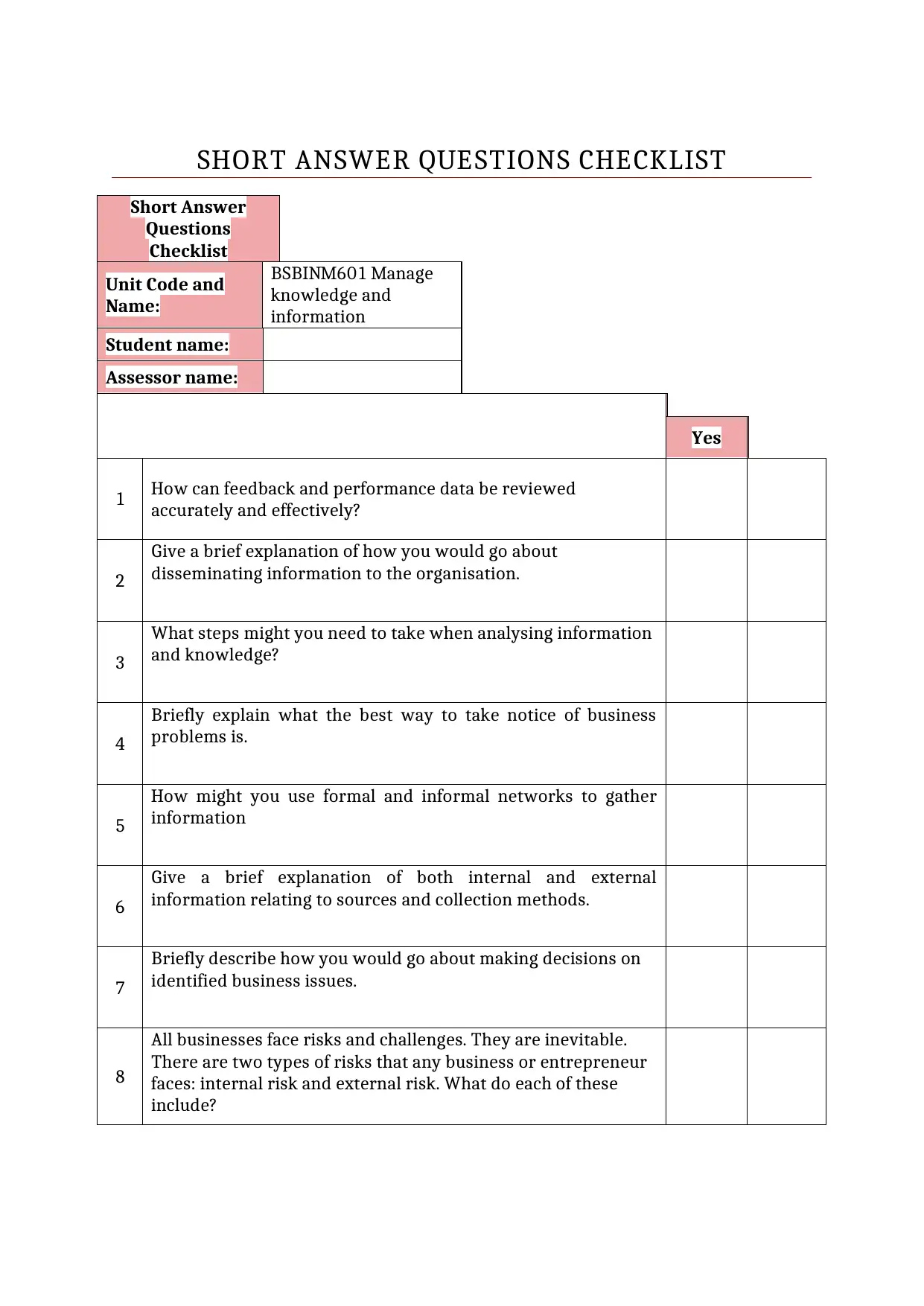
SHORT ANSWER QUESTIONS CHECKLIST
Short Answer
Questions
Checklist
Unit Code and
Name:
BSBINM601 Manage
knowledge and
information
Student name:
Assessor name:
Yes
1 How can feedback and performance data be reviewed
accurately and effectively?
2
Give a brief explanation of how you would go about
disseminating information to the organisation.
3
What steps might you need to take when analysing information
and knowledge?
4
Briefly explain what the best way to take notice of business
problems is.
5
How might you use formal and informal networks to gather
information
6
Give a brief explanation of both internal and external
information relating to sources and collection methods.
7
Briefly describe how you would go about making decisions on
identified business issues.
8
All businesses face risks and challenges. They are inevitable.
There are two types of risks that any business or entrepreneur
faces: internal risk and external risk. What do each of these
include?
Short Answer
Questions
Checklist
Unit Code and
Name:
BSBINM601 Manage
knowledge and
information
Student name:
Assessor name:
Yes
1 How can feedback and performance data be reviewed
accurately and effectively?
2
Give a brief explanation of how you would go about
disseminating information to the organisation.
3
What steps might you need to take when analysing information
and knowledge?
4
Briefly explain what the best way to take notice of business
problems is.
5
How might you use formal and informal networks to gather
information
6
Give a brief explanation of both internal and external
information relating to sources and collection methods.
7
Briefly describe how you would go about making decisions on
identified business issues.
8
All businesses face risks and challenges. They are inevitable.
There are two types of risks that any business or entrepreneur
faces: internal risk and external risk. What do each of these
include?
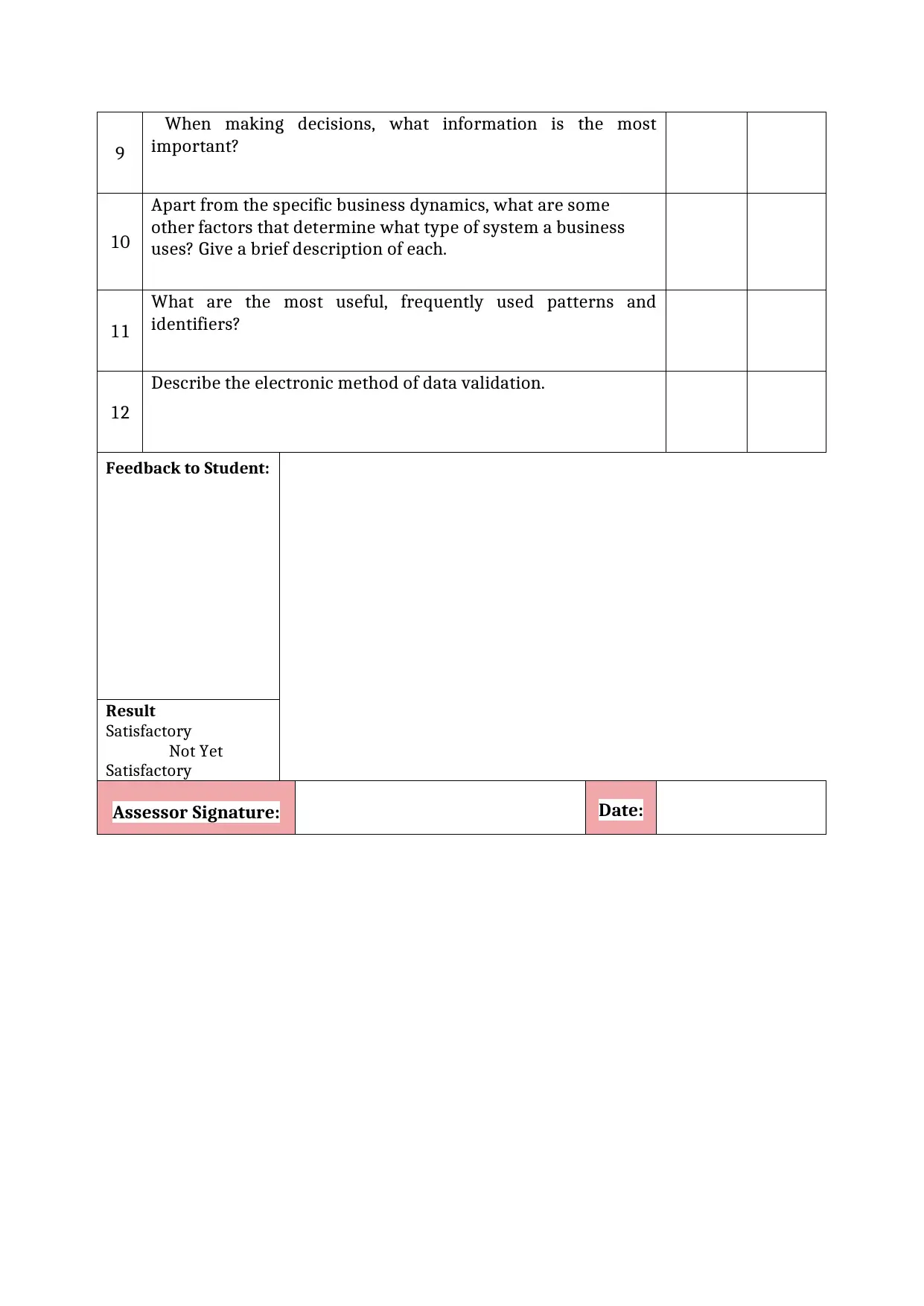
9
When making decisions, what information is the most
important?
10
Apart from the specific business dynamics, what are some
other factors that determine what type of system a business
uses? Give a brief description of each.
11
What are the most useful, frequently used patterns and
identifiers?
12
Describe the electronic method of data validation.
Feedback to Student:
Result
Satisfactory
Not Yet
Satisfactory
Assessor Signature: Date:
When making decisions, what information is the most
important?
10
Apart from the specific business dynamics, what are some
other factors that determine what type of system a business
uses? Give a brief description of each.
11
What are the most useful, frequently used patterns and
identifiers?
12
Describe the electronic method of data validation.
Feedback to Student:
Result
Satisfactory
Not Yet
Satisfactory
Assessor Signature: Date:
1 out of 10
Related Documents
Your All-in-One AI-Powered Toolkit for Academic Success.
+13062052269
info@desklib.com
Available 24*7 on WhatsApp / Email
![[object Object]](/_next/static/media/star-bottom.7253800d.svg)
Unlock your academic potential
© 2024 | Zucol Services PVT LTD | All rights reserved.





